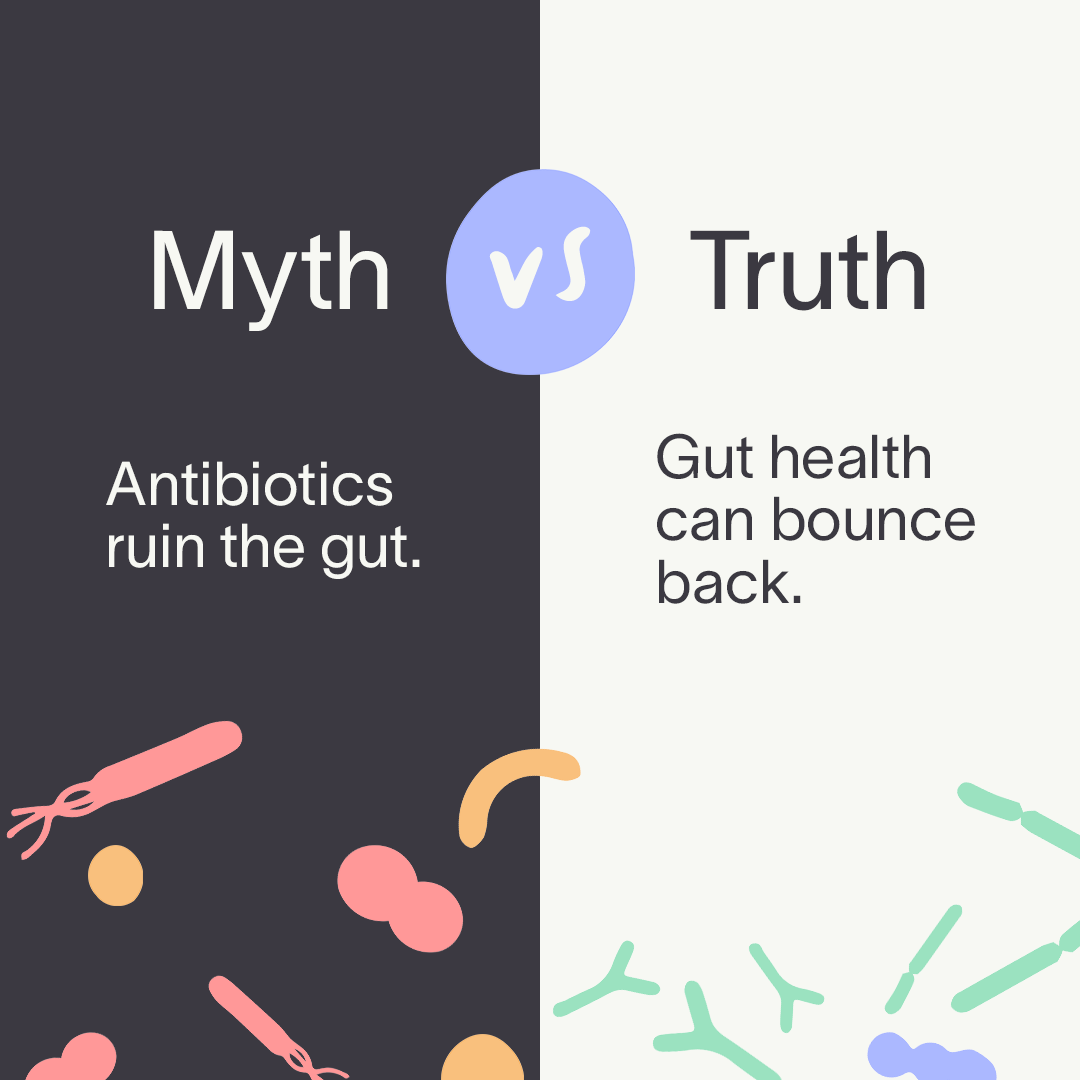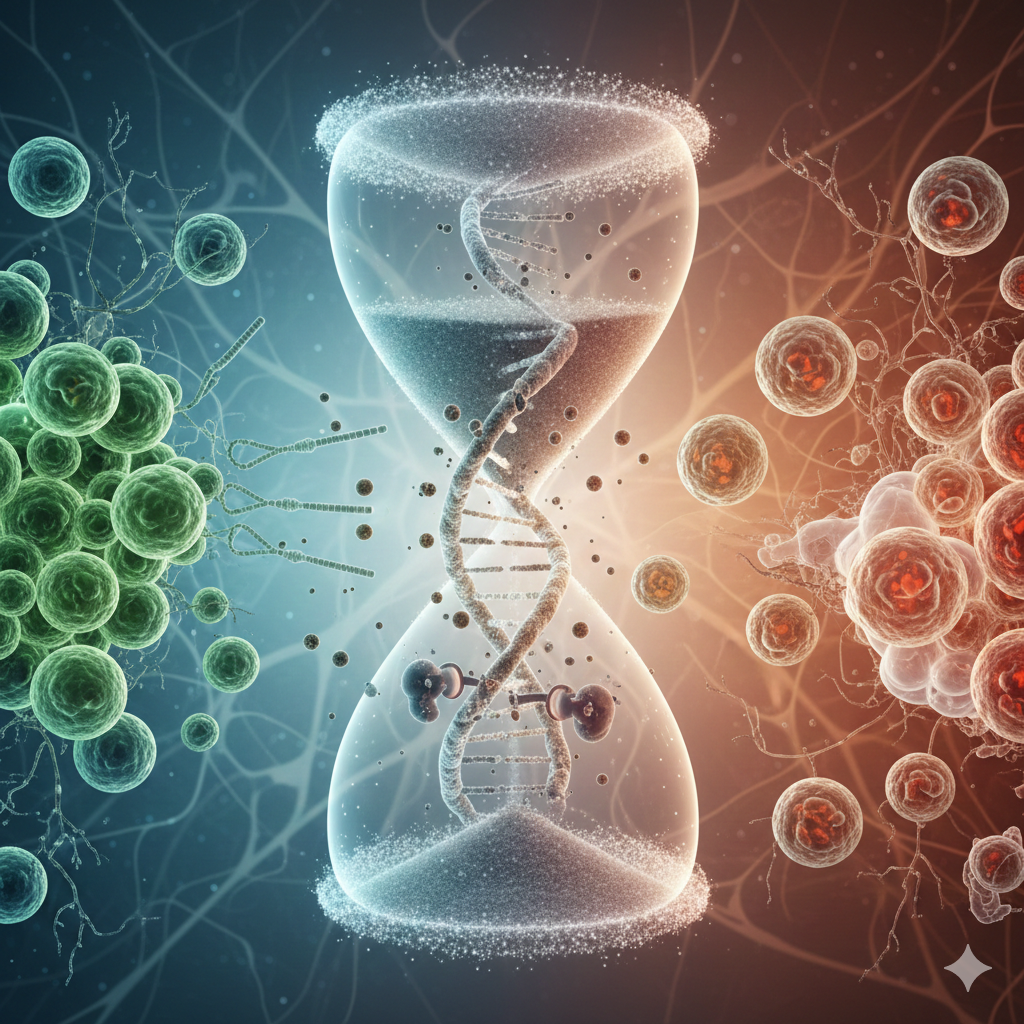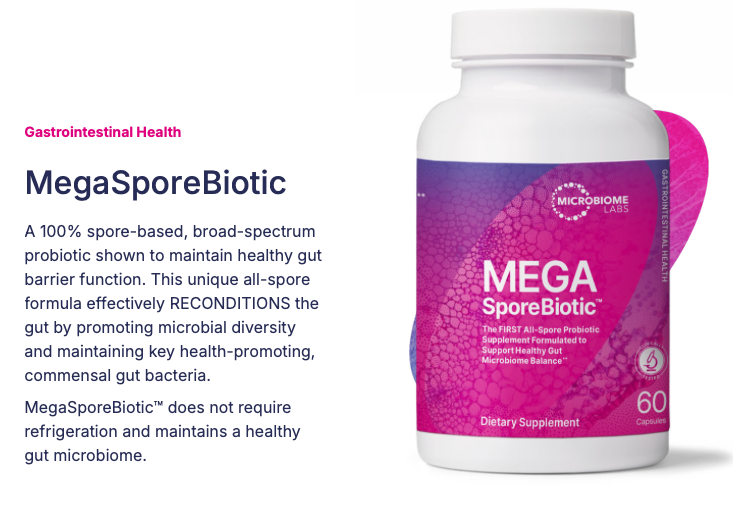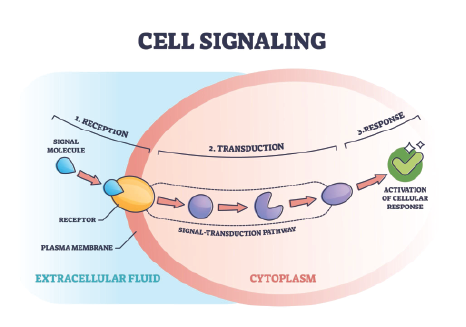Myth vs Truth: Do Antibiotics Ruin Gut Health?

Restoring gut bacteria after antibiotics
If you have ever gone on vacation to a tropical paradise the first thing people tell you is “don't drink the water.” Well that is good advise however during an evening of dancing and music we might accidentally eat or drink the wrong thing and have violent diarrhea or vomiting. To stop this digestive trauma, the doctor may prescribe antibiotics and many times this gives some relief, at least we are can start getting back to normal or so we think. The violent digestive trauma is gone but discomfort lingers on and things in a subtle way just don't feel right.
We can't talk about the digestive track in any rational way unless we address the full scope of the microbiome. We have to consider the full recognition of how antibiotics affected gut health. Most people don't realize that our microbiome in our colon provides more the 60% of our immunity response. To once and full all get it back in balance and healthy again we need certain spore biotics, particularly from the Bacillus strain. So in true Dr. Johnny fashion I will give the history and research from Microbiome Labs for a more in-depth discussion of spores.
History of Bacillus Spores
During WWII, more German soldiers stationed in North Africa were dying from dysentery than in battles. The Germans noticed that when the locals became ill, theyfound dried camel dung and consumed it. Yes, they ate it right on the spot. Something in the camel dung was fighting dysentery and other infections, so they took some camel dung back to the pharmaceutical companies in Germany.
Late 1940's - Bacillus clausii was isolated and used as a prescription spore probiotic in Germany (Enterogermina). Primarily used to treat dysentery, chronic upper respiratory infections, and other immune dysfunctions in kids and adults. Enterogermina is still on the market today (made in Italy). Since 1958: Bacti-Subtil (France) also entered the market as a prescription. There are at least 14 well-established spore drugs on the market in Europe, South East Asia, and Latin America, in addition to products used in agriculture and aquaculture.
First forward to today in Florida, Dr. Johnny's home state, when starting in 2005 - Microbiologist, Kiran Krishnan, was tasked with developing the most effective probiotic that not only survives and thrives, but contains probiotic strains native to the gastrointestinal tract. He asked - What would be nature's probiotic? How would we encounter them in nature? What are they and what would they do in the body? The obvious answer - would be something that mimics nature. Kiran and Dr. Tom Bayne realized the incredible potential of Bacillus spores and started the research process to bring Bacillus spores to manufacturing.
2012 - After 7 years, the research team achieved the very difficult task of stabilizing the spores for supplement manufacturing founded Microbiome Labs and MegaSporeBiotic their flagship product entered the market
The reason for spores inherent survivability comes from their bi-phasic life cycle. This means that the Bacillus spores can transition interchangeably from their dormant form to their active form, depending on the environment. In its dormant spore form, Bacillus
will surround itself with an endospore, which is a tough, natural outer shell that protects it from light, harsh temp., lack of oxygen, low PH, gastric barriers, antibiotics, UV radiation, solvents, enzymes, and even high pressures. This key feature is what allows MegaSporeBiotic™ to survive easily through digestion without the need for enteric- coated capsules or refrigeration.
Bacillus spores open in the intestines, tumble around the lining of the gut, then a molecular handshake happens welcoming them into the environment, and they open up.
They become metabolically active and start quorum sensing. They read microbial signatures of bacteria in the environment. Because they have evolved with us, they know which bacteria should and shouldn't be there so they will read their chemical signatures, identify pathogens that are overgrown, sit next to them, and compete with them.
Bacillus Spores in MegaSporeBiotic
- Bacillus Subtilis Bacillus Licheniformis Bacillus Coagulans Bacillus Clausii Bacillus Indicus HU36
- Most widely used and well-studied strains in humans are: Spores that modulate the microbiota through quorum sensing.
- Quorum sensing is a cell-to-cell communication process that enables bacteria to collectively modify behavior in response to changes in the cell density and species composition of the surrounding microbial community.
- Bacillus spores produce a significant number of antimicrobials that control bacterial overgrowth in the GUT. There are over 17of these antimicrobials.
- Spores conduct competitive exclusion (CE) of pathogenic organisms to help maintain microbiota balance. CE is accomplished by competing for space and nutrients.
- Spores have the ability to increase the numbers of important GIT commensals such as Lacto., Bifido., Akkermansia, F. Pauznitzii.
- This is important when we are achieving Microbiome Balance.
MegaSporeBiotic™ can increase microbial diversity by changing the pH, crowding out unwanted pathogens, and increasing the production of short-chain fatty acids.
These spores are found all over the environment (soil, vegetation, dust, rocks, aqua- environments, digestive systems of insects, marine life, mammals, humans, etc.) Studies indicate that the environment is simply a vector to transfer the bacteria from host to host, the spores are better suited for life in the GI, but designed to be passed via the environment.
They colonize very effectively in the human gastrointestinal tract and several different animals. The spores in MegaSporeBiotic are part of the normal human commensal flora. They are true commensal organisms and their mechanisms should be noted.
MegaSporeBiotic™ contains five Bacillus spore-forming bacterial strains. Spore- formers surround themselves with a protective coat, so they are naturally designed to navigate digestion with 99.99% survivability. They arrive in the gut, transition from spore to active form, and provide practical reconditioning support.
MegaSporeBiotic™ can support increased microbial diversity, maintain healthy gut barrier and immune function, and support keystone bacterial species that produce valuable short-chain fatty acid (SCFAs) metabolites, including butyrate. SCFAs support many diverse physiological processes necessary for optimal health and well-being.
MegaSporeBiotic™ is the first, truly innovative, multi-spore-based probiotic. Check the Patient Register link to fill out the form and then purchase this powerhouse probiotic.
Mechanisms of Action:
- Reconditions the gut by increasing microbial diversity
- Bacillus spores compete with pathogens for space and nutrients and produce antibiotic compounds
- Encourages the growth of key, health-promoting bacteria such as Akkermansia muciniphila, Lactobacillus, Bifidobacterium, Faecalibacterium prausnitzii, and more.
- Maintains healthy gut barrier and immune system
- Supports tight junction proteins 99.9% survival during digestion and does not need to be refrigerated 5 human commensal Bacillus strains that are found in a healthy human gut and colonize the GI tract.
- May increase butyrate production by up to 40%
- Gut Model study demonstrates a nearly 30% shift in microbiota population with continuous administration of our bacillus spores
- First 100% spore-based probiotic clinically shown to improve leaky gut by 60% in just 30 days
30-Day supplementation with MegaSpore resulted in:
- 42% reduction in circulating LPS following a high-fat meal
- 24% reduction in triglyceride levels (36% reduction in 90-days), improved gut brain connection and metabolic markers.
- Supports immune function, improves cytokine balance, reduction in loose stools
A deeper look at the 5 different probiotics in MegaSporeBiotic
Bacterial spores are dormant life forms that can exist in a desiccated and dehydrated state indefinitely. Each spore-forming strain has its own unique set of benefit survivability:
Why Understanding Probiotic Mechanisms Matters
When it comes to probiotics—especially following a course of antibiotics—it’s not just about whether they “work,” but how they work within our gut ecosystem. A clear mechanistic understanding is crucial because probiotics can influence the composition and function of your microbiome long after you finish taking them. In some cases, these effects can speed recovery and restore balance, but in others, they might unintentionally delay your gut’s return to its natural state.
Think of introducing probiotics like replanting a garden after a storm: adding the right mix of plants can help your plot flourish, but choosing the wrong ones—or not understanding their effects—could hinder regrowth or let weeds take over. That’s why knowing the ins and outs of how these microbial strains interact with your unique flora, especially after antibiotics have cleared the field, is vital for supporting true recovery and resilience in the gut.
How Probiotics Can Support Other Beneficial Gut Bacteria
One fascinating way probiotics make an impact is by supporting the growth of other helpful microbial residents in your gut. For instance, certain strains, while they might not permanently take up residence themselves, can act as friendly "boosters" by producing antimicrobial compounds—think of them as bodyguards that keep troublemakers in check. These compounds, known as bacteriocins, help reduce competing or harmful bacteria, creating a friendlier environment for beneficial groups like the Muribaculaceae family to thrive.
In other words, even if a probiotic isn’t setting up a long-term camp in your gut, it can still encourage your native good guys to flourish—ultimately strengthening the entire ecosystem.
- Bacillus Indicus, HU36: potent immune stimulation, produces carotenoids (lycopene, astaxanthin, beta-carotene, & lutein) at the site of absorption, most effective antioxidant probiotic strain on the market
- Bacillus Subtilis, HU58: produces over 24 antibiotics, strongest competitor, produces nattokinase & K2, shown to lower Il-6 & TNF-a, highly important for immune development – GALT, (gut associated lymphoid tissue) strong production of SCFA's (short chain fatty acids)
Interestingly, while Bacillus Subtilis itself is a powerful gut colonizer and competitor, it also demonstrates a remarkable ability to support the broader gut ecosystem. For instance, certain strains, like those found in MegaSporeBiotic, not only produce crucial antimicrobial peptides (bacteriocins) but can also encourage the growth of other beneficial microbes, fostering a balanced and resilient microbiome. This cross-talk among bacteria is essential for outcompeting pathogens and maintaining gut health, much like how L. gasseri produces bacteriocins and supports the proliferation of helpful bacteria like Muribaculaceae. - Bacillus Coagulans (SC-208): produces L+optical form of lactic acid, increases nutrient absorption by producing digestive enzymes, increases absorption of BCAA's, improves peristalsis, reduces inflammatory metabolites
Beyond its role in lactic acid production, Bacillus Coagulans creates an environment that favors the growth of beneficial bacteria by lowering gut pH and suppressing undesirable species. This not only enhances nutrient uptake but also helps sustain a diverse microbial community, echoing the way certain probiotics can shape the composition and function of the gut flora for sustained wellness. - Bacillus Licheniformis (SL-307): produces antibiotic bacitracin, produces protease, improves protein digestion, produces full spectrum of B vitamins and folic acid
In addition to its direct digestive benefits, Bacillus Licheniformis contributes to a synergistic gut environment. By breaking down proteins and synthesizing essential nutrients, it creates conditions favorable for the proliferation of other health-promoting microbes. This collaborative effect is key to a thriving microbiome, ensuring that beneficial bacteria not only survive, but help each other flourish. - Bacillus Clausii (SC-109): antibiotic-resistant during antibiotic use, supports immune function, improves cytokine balance, reduction in loose stools
Are There Risks in Taking Certain Probiotics After Antibiotics?
It might come as a surprise, but not all probiotics are beneficial after a course of antibiotics—especially when it comes to reestablishing your gut’s natural defenses. Some well-known probiotic strains don’t always behave as we expect, particularly when it comes to disrupting harmful bacteria like C. difficile.
For example, two popular strains, Lactobacillus acidophilus and Lactobacillus gasseri, have demonstrated very different impacts in post-antibiotic environments. In studies with mice, taking L. acidophilus actually delayed the gut’s ability to bounce back and left animals more vulnerable to C. diff infection in the short term. Meanwhile, L. gasseri seemed to help the gut restore its protective barrier more quickly, possibly because it produces compounds that can directly inhibit unwanted bacteria.
What’s important to remember is that the effects of probiotics can persist well after you’ve stopped taking them—and in some cases, certain strains may unintentionally prolong imbalances or even worsen problems. We see that, without any probiotics, the gut often restores itself within several weeks after antibiotics. Introducing the wrong probiotic at the wrong time can throw a wrench in that recovery.
Key takeaways:
- Some probiotics, like L. acidophilus, may slow down gut recovery after antibiotics, increasing susceptibility to harmful bacteria.
- Others, like L. gasseri, may help, but their benefits are strain-specific and not one-size-fits-all.
- Everybody’s gut is unique—what works in one situation might not work in another. That’s why it’s crucial to choose probiotic strains with proven benefits for post-antibiotic recovery, not just any “friendly bacteria” off the shelf.
With this in mind, let’s shift our focus to how spore-forming strains in MegaSporeBiotic approach gut restoration differently...
Why Each Probiotic Strain Deserves a Closer Look
One thing that often gets missed in probiotic conversations is that not all strains work the same way—or even in the same direction—when gut health is trying to bounce back from antibiotics. Recent findings from researchers (who are just as obsessed with bacteria as we are) support the idea that these positive little bugs can have very different, sometimes surprising impacts on restoring your microbiome.
So, why do we need so much more research on specific strains?
- Strain-Specific Impact: Each probiotic isn't just a generic “good guy.” Their benefits are highly specific, depending on the individual’s own gut environment, the type of antibiotic used, and your body’s unique needs. For instance, while Bacillus Clausii can hang tough through antibiotics and help balance immune response, other strains may just pass through with subtler effects.
- Recovery Timelines Can Vary: Certain strains might help your gut bounce back faster, while others could even slow the process—yes, really! This means it’s not enough to pop just any probiotic and hope for a miracle.
- Complex Interactions: Probiotics can create ripple effects, working indirectly to promote the growth of other beneficial bacteria or to support natural gut resilience. Sometimes, their influence lingers even after they're gone, changing the landscape of your microbiome long-term.
- No “One Size Fits All”: Results can differ not just between strains but also between people. What’s great for one person's recovery could complicate another’s. That’s why tuning in to exactly which strains and combinations have the best outcomes for specific situations is so critical.
The bottom line: more targeted research helps us understand which strains will deliver real, lasting results after the antibiotic dust settles—so you’re not left guessing or playing “gut roulette.” And that's exactly why we value the carefully chosen blend of spore-based strains in MegaSporeBiotic…
How beneficial gut bacteria help keep C. difficile in check
When certain beneficial bacteria in our gut—like M. intestinale and D. muris—are allowed to flourish, they make it much harder for troublemakers like Clostridium difficile to gain a foothold. In laboratory settings, researchers have found that higher populations of these good guys can actually prevent C. difficile from growing out of control. The idea here is simple: the right bacterial balance creates an environment that's less inviting for harmful strains, crowding out the bad actors and boosting colonization resistance. This is yet another reason why supporting your microbiome with targeted probiotics can be essential after any disruption, such as a round of antibiotics.
Do probiotics have lasting impacts on the gut even after they’re gone?
It turns out that probiotics can influence the gut microbiome in ways that extend beyond their direct presence. Think of certain strains as helpful guests—while they might not stick around forever, their short visit can nudge the resident microbial community in the right direction. For example, some probiotics temporarily support the growth of beneficial bacteria, foster a more resilient microbiome, or even prime the immune system in the aftermath of antibiotic use.
So, even after these strains are no longer detectable in your digestive tract, the positive changes they set in motion can continue. This lingering influence is part of what makes spore-forming probiotics like those in MegaSporeBiotic unique—they kick-start a series of beneficial shifts that help set the stage for a healthier gut long-term.
Can probiotics help – or hinder – your gut’s recovery after antibiotics?
Now, here’s where things get really interesting: Not all probiotics play the same role when it comes to helping your gut bounce back from antibiotics, especially when we talk about that notorious troublemaker, Clostridioides difficile (a.k.a. C. diff).
Recent research suggests the story is more complex than simply adding any probiotic to your regimen. Scientists put two well-known probiotic strains to the test in a mouse model following antibiotic treatment: Lactobacillus acidophilus and Lactobacillus gasseri. The results may surprise you:
- With L. acidophilus: Mice given this strain actually saw an increase in C. diff infection and slower recovery of “colonization resistance”—that is, the gut’s natural ability to block harmful bacteria from taking over.
- With L. gasseri: This group fared much better, showing improved resilience against C. diff and faster recovery, even though L. gasseri didn’t stick around in the gut for long.
The real twist? It wasn’t just the probiotic strain itself doing the heavy lifting. L. gasseri appeared to encourage the growth of helpful native bacteria—specifically, members of the Muribaculaceae family—which played a direct hand in blocking C. diff.
What does this mean for you?
Probiotics aren’t one-size-fits-all, especially after antibiotics. In some cases, certain strains might even delay your gut’s recovery instead of speeding it up. The interplay between probiotics, your microbiome, and colonization resistance is intricate, and the effectiveness of a probiotic can depend on its specific actions—and on how it interacts with your existing gut bacteria.
So, while popping any over-the-counter probiotic may seem helpful, choosing strains with proven post-antibiotic benefits is key. Formulations featuring robust spore-formers (like those found in MegaSporeBiotic) may offer a broader spectrum of support, promoting both direct and indirect resistance to invaders like C. diff, and supporting the regrowth of your natural, healthy microbiome.
The role of Muribaculaceae in colonization resistance
The gut microbiome is a complex ecosystem, and its ability to defend against harmful invaders like C. difficile depends on the presence and activity of specific beneficial bacteria. Recent research highlights the importance of the Muribaculaceae family, a group of underappreciated gut bacteria, in boosting colonization resistance.
Studies reveal that when certain probiotic strains—like Lactobacillus gasseri—are introduced into the gut, Muribaculaceae can flourish even though the original probiotic may not stick around for long. This bloom in Muribaculaceae does more than just take up space. Laboratory experiments show that increased levels of Muribaculaceae species such as M. intestinale and D. muris can actively inhibit the growth of C. difficile.
Here's how it works:
- Indirect defense: Instead of acting as a shield themselves, some probiotics encourage the growth of Muribaculaceae, which can then act as a barrier.
- Competition for resources: The expansion of Muribaculaceae helps crowd out and limit the resources available to unwanted pathogens.
- Metabolic byproducts: These bacteria can produce substances that directly suppress the growth and activity of C. difficile.
What does this mean for recovery, especially after antibiotics? While some probiotics don't always take up long-term residence in our gut, they can spark favorable changes—essentially passing the torch to native beneficial bacteria like those in the Muribaculaceae family. This hand-off is a crucial factor in rebalancing the gut and preventing further infections.
Therefore, reestablishing a healthy population of Muribaculaceae seems to be a key player in restoring colonization resistance after antibiotic use. Supporting the growth of these and other beneficial strains points the way to smarter probiotic strategies, engineered not just for survival but for lasting health benefits through ecosystem cooperation.
What about Lactobacillus strains after antibiotics?
Curious how specific probiotic strains affect the gut after antibiotics? Recent animal studies shed light on what happens when two popular Lactobacillus strains—L. acidophilus and L. gasseri—are introduced following antibiotic treatment.
Here's what stood out:
- Mice given no probiotics saw a steady recovery in their gut bacteria, regaining resistance to C. difficile over a four-week period post-antibiotics.
- Supplementing with L. acidophilus introduced some bumps in the road. Rather than a straight path to recovery, these mice actually experienced increased bacterial growth in the gut during the second and third weeks—alongside a less predictable resistance profile.
- In contrast, L. gasseri showed a different pattern: no detectable C. difficile remained after two weeks, suggesting a robust improvement in resistance. Interestingly, L. gasseri itself didn’t stick around in the gut but worked more like a catalyst—producing beneficial antimicrobial compounds and encouraging the rise of other supportive bacteria, such as Muribaculaceae.
What does this mean in plain terms? The type of Lactobacillus you choose post-antibiotics can make a big difference—not just in repopulating your gut, but in how resilient your microbiome becomes in the face of opportunistic invaders like C. diff. Some strains do much more than just take up space; they create a healthy environment for your native microbes to thrive.
With
MegaSporeBiotic we can be assured that after that round of antibiotics that saved our lives we can eliminate that lingering discomfort with an imbalanced microbiome. Click on the Patient Registration link and purchase MegaSporeBiotic today.

Dr. Michael Rudulph Maxon, AKA Johnny Delirious, Laboratory Naturopathic Doctor, gives expert advice rooted in holistic healing principles, drawing on 40 years of professional experience in the health industry. He helps his patients recover and heal using food and Ancient Greek therapies, utilizing organic remedies that are all backed by modern laboratory science. He is unquestionably the only TRUE Addiction & Hepatitis A, B, and C Recovery Pioneer. Free of mood-altering substances (cocaine) since 1991, with no viral load or antibodies of hepatitis since 1994, and no cirrhosis since 1995. Nobody in his life—including doctors, friends, and family—thought he would live past 1992; they all said he was going to die. But, Johnny chose life, not death, and learned how to heal his body, mind, and spirit by developing new protocols with natural therapies, including the thoughtful application of homeopathic remedies where appropriate. For over 20 years, he has helped many others recover, including professionals like doctors, dentists, and lawyers, who prefer alternative medicine over chemical drugs or surgery to address the same conditions that everyone said were hopeless.
Contact Johnny for a Hair Tissue Mineral Analysis (HTMA) to get the right diet, supplements, and expert advice, benefiting from his 30 years of experience in these specialized protocols.
United States - 972-825-7912
http://www.johnnydelirious.com



